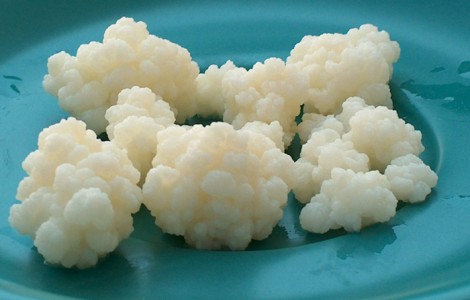 Kefir is derived from the Turkish word, keif, which means “feeling good” or “feeling good”.
Kefir is derived from the Turkish word, keif, which means “feeling good” or “feeling good”.
Kefir grains were considered a gift from Allah among members of the Muslim tribes of the Caucasus Mountains. The inhabitants of this region drink kefir daily and make it a meal. Interestingly, there is an average longevity of 110 years in these populations, but no scientifically sustained cause-effect relationship has been established.
But, how did they come about, what are they and how do these grains develop?
This fermented milk drink, with this probiotic gem (pro=for; bio=life), has been respected as having curative properties since the beginning of the XNUMXth century. It was initially produced by nomadic shepherds who left the milk in leather bags and introduced as colonies of microorganisms, intestinal flora from goats or sheep.
Kefir is a product obtained through the fermentation of fresh milk or water with sugar, by white or yellowish grains, of gelatinous consistency, commonly called kefir grains and, often mistakenly, “yogurt flower”. It is classified as an alcoholic-acid fermented milk, as its composition may contain a percentage of alcohol varying between 0,5 and 1%.
These grains are colonies of symbiotic microorganisms, bacteria and yeasts, immersed in a matrix of polysaccharides (sugars) and proteins (casein), looking similar to small pieces of coral or cauliflower.
When placed in milk, they consume lactose and reduce casein, albumin and other proteins to the constituent amino acids, in addition to synthesizing lactic acid, lactase and other enzymes that help digest the lactose remaining after ingesting. Calcium salts are also modified to forms more easily absorbed by the human body.
When placed in sugar water, they ferment glucose. In both cases, they incorporate beneficial bacteria and yeasts in the final product. Kefir can be made from any source of milk, animal or vegetable. Its size varies between a grain of corn or a nut.
It develops preferably at room temperature, between 20 and 37ºC, for 12 to 24 hours, with a marked acidity and altered nutritional constitution, during fermentation.
Its bittersweet and refreshing taste, as well as the creamy texture, are similar to yogurt or plain yogurt drinks. The difference lies in the various types of beneficial bacteria used. Yogurt contains transient beneficial bacteria that keep the digestive system “clean” and provide food for the beneficial bacteria that inhabit it. Kefir also colonizes the intestinal tract with beneficial bacteria.
Bacteria like, Lactobacillus caucasus, Leuconostoc, and species of acetobacter e streptococcus, are not common in yogurt. Kefir also contains beneficial yeasts such as Saccharomyces Kefir e Torula Kefir, which dominate, control and eliminate pathogenic yeasts present in the body.
In addition to this diversity of microorganisms, kefir contains very important nutrients such as: proteins of high biological value, calcium, phosphorus and magnesium, B complex vitamins, including vitamin B12, B1 and biotin, and vitamin K.
As it is a live food, it is usually obtained from the culture of someone, friend or acquaintance, who gives a little of the portion that has grown in the meantime. By sharing kefir, sharing life!
scallop daisy
Science in the Regional Press


















Comments